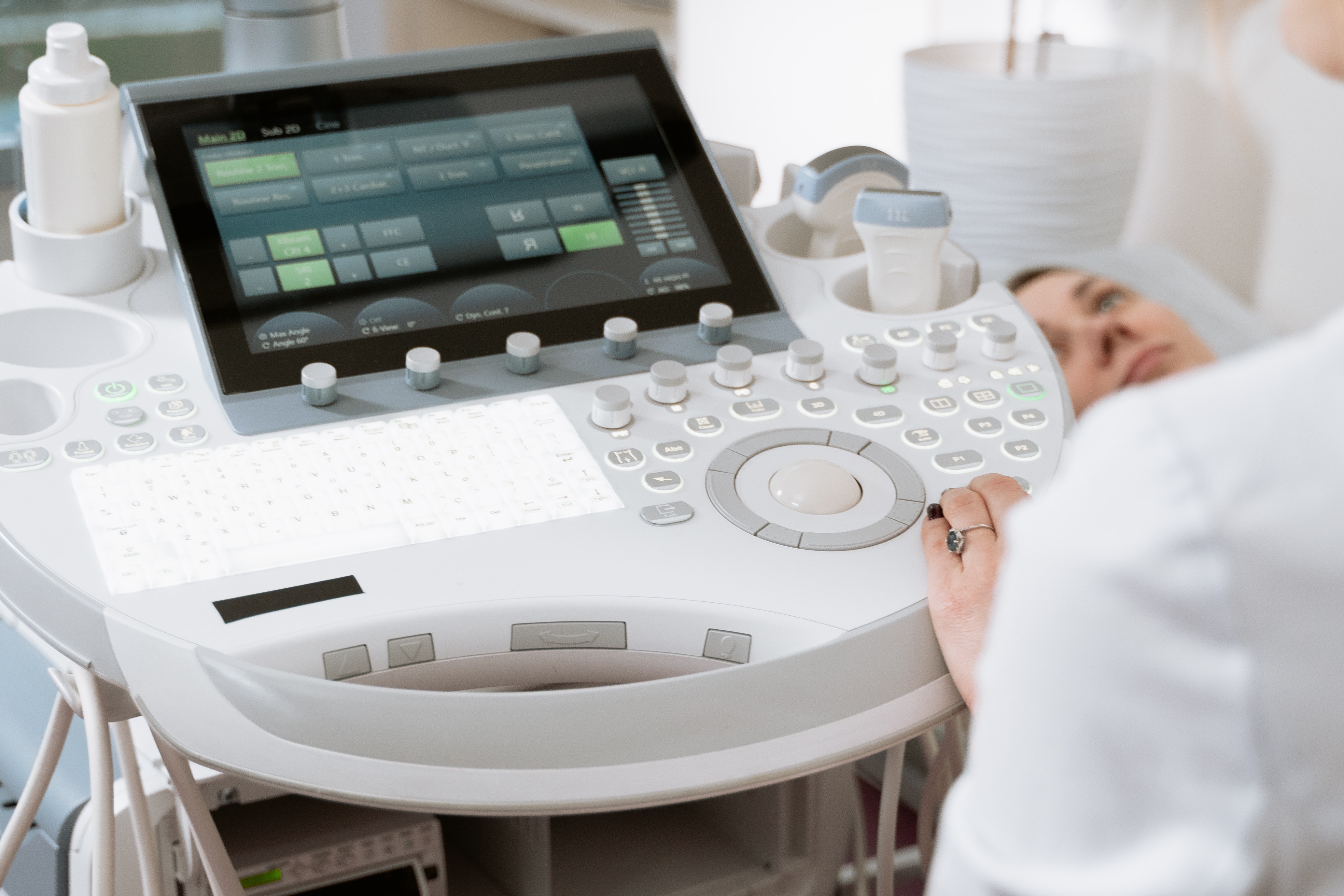Doppler Ultrasound Test
Vascular (venous and arterial) ultrasound scans provide valuable insights into the function of the blood vessels and circulatory system. They are an important tool for assessing blood clots and blockages, including deep vein thrombosis (DVT).
Doppler ultrasounds also enable the imaging of substances while they are moving through the body. This is especially useful for studying the rate of blood flow, and often forms part of a vascular, venous or arterial ultrasound scan.
Looking to book? Search for a doppler ultrasound near you.
Duplex ultrasound vs Doppler
When a doppler ultrasound and vascular ultrasound are combined, they are referred to as a duplex ultrasound, as they contain two tests. It is common for these tests to be done together, as you get the rate of blood flow with doppler, vs duplex ultrasound providing an anatomical image of the vein and artery structures as well as rate of blood flow.
What is a vascular ultrasound scan, and what is a doppler test?
An ultrasound scan works by using high-frequency sound waves, which are emitted from a special probe called a transducer. The transducer disperses the sound waves into your bodily tissues, and then records the echoes as they bounce off the different tissues and structures. A computer uses this information to generate an image of the body in real time.
The vascular system is responsible for transporting blood, oxygen and other important nutrients around the body. It is also called the circulatory system.
Ultrasound allows images to be captured of the veins and arteries, to check their health and function, and look for any abnormalities such as blockages.
Meanwhile, doppler ultrasound scans can record the rate of blood flow quickly and accurately. Doppler ultrasounds can be used to assess how blood is moving through your circulatory system. It can measure the speed and direction of blood flow, as this affects the change in pitch of the ultrasound waves.
Types of doppler ultrasound scan
Venous doppler ultrasound
Venous ultrasound produces images of the veins to check for clots and structural issues. Doppler ultrasound scans can identify any problems with the rate of blood flow, which could be a sign of a clot.
Carotid doppler scan
A carotid scan is actually an arterial scan. You have two carotid arteries, one on either side of your neck, and they supply the brain with oxygen. A carotid ultrasound scan will show the structure of these blood vessels, while a duplex or carotid doppler test will also include information about the rate of blood flow through the arteries.
DVT doppler ultrasound
A doppler for your legs is usually used to locate and assess a deep vein thrombosis (DVT), which is a blood clot that has formed in the deep veins of the leg, below the leg muscle, often in the calf area but they can also occur in the thigh area. Doppler tests can determine whether blood is flowing normally. If it isn’t, it could be a sign of a clot.
Transcranial doppler ultrasound
Transcranial doppler ultrasound checks the blood flow through the vessels in the brain, to check for potential stroke, narrowing of blood vessels, or tiny blood clots (cerebral microemboli) that can cause a mini stroke.
Uterine doppler scan
A doppler test that is often done while pregnant is a uterine doppler scan. It may be used if you are at risk of developing pre-eclampsia to check if your blood is flowing easily with little resistance, or if it has higher resistance.
When it comes to doppler ultrasound, pregnancy is a safe time to have an ultrasound as it is a non-invasive procedure.
What does a vascular ultrasound show?
Ultrasound scans enable images to be captured in real-time on a screen, and the images are usually in black and white, with different levels of shading based on the tissues being scanned.
Vascular ultrasound scans enable imaging of the circulatory system, including veins and arteries, the blood flowing through them, and their overall function.
Doppler ultrasounds can be used to create graphs of the rate of blood flow in the area being scanned.
What can vascular and doppler ultrasound scans detect or diagnose?
Vascular ultrasound is an important tool for the detection and diagnosis of a wide range of circulatory problems. These include:
- Problems with the blood flow to organs and bodily tissues, such as reduced blood flow or increased blood flow, which could be a sign of infection
- Blockages and abnormalities, such as stenosis, plaque or embolisms
- Blood clots, such as deep vein thrombosis (DVT), usually in the legs or arms
- Aneurysms in the abdominal aorta
- Stroke risk in the carotid arteries
- Varicose veins
- Narrowing of the blood vessels
- Tumours
Is an ultrasound scan of the vascular system safe?
Ultrasound scans have no known side effects, and are safe and non-invasive medical imaging procedures. There is no risk of radiation exposure, which differentiates ultrasound scans from CTs and X-rays.
Most people are suitable patients for a vascular ultrasound scan, and it is a quick, simple and safe procedure.
To find out more about ultrasound scans, you can visit our definitive guide.
How to prepare for a vascular or doppler ultrasound:
Ultrasound scans do not usually require extensive prior preparations. You are usually asked to wear loose, comfortable clothing, but you might need to change into a hospital gown for your scan.
Depending of the urgency and reason for your scan, you might be asked to fast for a few hours before the scan. We will always let you know of any necessary preparations in advance of your appointment.
Vascular ultrasound: what to expect on the day
Ultrasound scans are quick, simple and non-invasive. You can go about your day as normal after the scan, as ultrasound does not have any side effects.
On the day of your scan, you could expect the following steps to take place:
- You might be asked to change out of your clothes and into a hospital gown. You’ll also need to remove any jewellery that might interfere with the scan procedure.
- You’ll usually need to lie down on a flat couch for the scan, but depending on the area being scanned you might need to change position.
- The sonographer (scan technician) will apply a cool gel to the skin, to lubricate the area and prevent air bubbles from disrupting the scan images.
- During the scan, the sonographer will move the transducer across your skin. You should tell your sonographer if you are experiencing pain during the procedure as the scanning wand is applied to the skin.
- Doppler ultrasound scans are carried out with the same equipment.
- After the scan, you can resume your day as normal.
How long does a doppler test take?
An ultrasound scan of the vascular system can usually completed in less than than 30 minutes, depending on the area being scanned. If a doppler scan is included (duplex scan), this may extend the length of your appointment.
How long do vascular ultrasound results take?
After your scan, a radiologist will study your images, and write a report of their findings. This will be shared with our clinical team within 7 working days.
As soon as we receive your results, we will share the report with you by email, and our clinicians will provide a follow-up consultation to discuss the outcomes and next steps. If you need copies of your images for onward care, these can be provided on request.
For doppler test for the legs, results are quick to obtain, and your sonographer might share some thoughts on the day of your appointment, but your complete results will be shared within your report at the same time as any structural ultrasound results.
How much is a doppler ultrasound?
Doppler ultrasound scan price
Our ultrasound scans start from £219, and this price includes an extensive package of care, which goes beyond just having your scan. Book with us, and you’ll receive:
- A pre-scan consultation with a dedicated expert clinician, to discuss your symptoms and requirements
- Your choice of scanning centre, and a fast referral to your selected clinic
- Your ultrasound scan
- A radiologist’s report of your results
- Access to your scan images upon request
- A post-scan consultation with your clinician if any next steps are required
How can I find a private doppler scan near me?
- Book a private ultrasound today without a GP referral - our expert clinical team will take care of all the paperwork on your behalf.
- Search by scan type and postcode, and choose from 150+ private scanning locations and a range of prices and appointment times to suit you.
- Visit our news page to learn more about ultrasound scans and medical imaging
Sources used:
https://www.radiologyinfo.org/en/info/vascularus
https://www.hopkinsmedicine.org/health/conditions-and-diseases/overview-of-the-vascular-system
https://www.aksonogram.com/blog/what-is-a-vascular-ultrasound-and-why-do-it/
https://www.stoptheclot.org/learn_more/signs-and-symptoms-of-blood-clots/how_dvt_is_diagnosed/
https://vascularsurgery.ucsf.edu/conditions--procedures/carotid-ultrasound
https://www.westhertshospitals.nhs.uk/patientinformation/documents/maternity/33-1194-V1%20%20Uterine%20Artery%20Doppler%20Ultrasound%20Measurements.pdf

